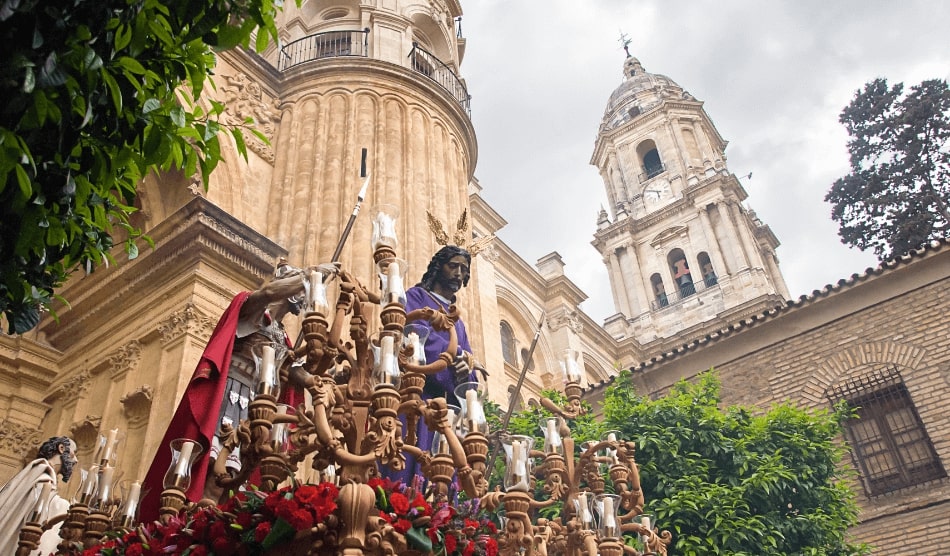La Semana Santa es una de las celebraciones religiosas más importantes de España, ya que, durante esta semana, las ciudades y pueblos del país se llenan de procesiones y actos litúrgicos que conmemoran la Pasión, Muerte y Resurrección de Jesucristo.
Para muchas personas, es una experiencia única que combina la religión y la tradición con el arte y la cultura, lo cual atrae a miles de turistas de todo el mundo cada año. Pero, ¿cómo podemos explicar la Semana Santa para alguien que no lo ha visto nunca? y, ¿encima en inglés?
Por este motivo, esta entrada de blog está enfocada en la historia de la Semana Santa y las diferencias que tiene con la Pascua en Reino Unido, pero, como siempre, con un giro lingüístico para poner a prueba vuestras capacidades en la lengua inglesa con ejercicios del estilo de Cambridge. ¿Te atreves?
Vamos con el primer texto. Este texto está diseñado para que se parezca a la segunda parte del UOE (Use of English) del examen oficial de Cambridge. Consiste en rellenar los huecos para que tengan tanto coherencia gramatical como léxica. Hay que fijarse muy bien en las palabras que van delante y detrás de los huecos ya que suelen ser las claves para saber qué palabra necesitamos.
Ejercicio de Use of English parte 2 sobre la Semana Santa
The history of Semana Santa in Spain dates (1) _________ to the Middle Ages, when the Catholic Church began to organise processions and other religious ceremonies to commemorate the Passion, Death and Resurrection of Jesus Christ. Over time, these celebrations became more elaborate, with the creation of religious brotherhoods and the development of the artistic and cultural aspects that characterize Semana Santa in Spain today.
During the 16th and 17th centuries, Semana Santa became an important way for the Church to assert its power and influence in Spain. The religious brotherhoods that organized the processions (2) ________ in number and influence, and began (3) _______ commission artists and craftsmen to create the ornate sculptures and decorations that are a hallmark of Semana Santa today.
In the 18th and 19th centuries, the tradition of Semana Santa spread throughout Spain, (4) ________ each region and city developing its own unique customs and traditions. In some places, like Seville and Málaga, the processions became grand spectacles that attracted thousands of visitors each year. In other places, like Castile and León, the focus was more on the religious aspects of the celebration, with solemn processions (5) _______ elaborate liturgies.
The 20th century saw significant changes in the way Semana Santa was celebrated in Spain. During (6) _____________ Spanish Civil War, many of the religious brotherhoods (7) __________ disbanded, and many of the sculptures and decorations were destroyed. However, after the war ended, the tradition was revived, and today Semana Santa is one of the most important cultural and religious events in Spain.
(8) _____________ the challenges of the COVID-19 pandemic, Semana Santa continues to be celebrated in Spain, although in a more limited way than in previous years. Nevertheless, the tradition and history of Semana Santa in Spain remains strong, and it continues to be a unique and vibrant celebration of faith, culture, and tradition.
Palabra 1:
Palabra 2:
Palabra 3:
Palabra 4:
Palabra 5:
Palabra 6:
Palabra 7:
Palabra 8:
Ni tan mal, ¿no? Pues vamos con la siguiente prueba. Como hemos dicho antes, la Semana Santa atrae a muchos turistas; sin embargo, para muchos, también la celebración de la Pascua es un momento para escaparse durante una semana a las costas de nuestro país. Por ello, hemos diseñado el siguiente ejercicio como una comparativa entre la Pascua en Reino Unido y España (ya que vienen muchos ingleses en estas fechas).
En cuanto a este ejercicio, tal como en el examen oficial de Cambridge, tienes que cambiar de categoría la palabra que viene en mayúscula. La clave aquí es fijarte muy bien en las palabras que vienen antes y después del hueco, y averiguar cual es la categoría de la palabra que te falta. Una vez hecho eso, tienes que pensar en cómo sería esa palabra con su categoría correspondiente. ¿Lo intentamos?
Ejercicio de Use of English parte 3 sobre la Semana Santa
In terms of explaining Semana Santa to someone from the UK, it may be (1) ___________ to start by comparing it to the Christian holiday of Easter. Both holidays have their (2) __________ based on the same religious story – the Passion, Death, and Resurrection of Jesus Christ – but the way they are celebrated is quite different.
In Spain, Semana Santa is a week-long celebration that begins on Palm Sunday and ends on Easter Sunday. During this week, cities and towns across Spain are filled with processions and religious ceremonies that (3) __________________ the events of the Passion. People dress up in traditional costumes and carry (4) ________________ sculptures of religious figures through the streets, while bands play music, and the air is filled with incense and the sound of church bells.
Unlike in the UK, where Easter tends to be a more (5) _______________ holiday, Semana Santa in Spain is a major event that attracts thousands of visitors from around the world. It’s a time for people to come together with their families and communities to celebrate their faith and their cultural heritage.
Of course, Semana Santa is also a time for food, drink, and (6)________________. People eat traditional foods like torrijas (a type of French toast), and drink sweet wines like muscatel. It’s also a time for people to enjoy the spring weather and the beauty of their cities and towns, which are often embellished with flowers and other festive (7) _______________ .
Overall, Semana Santa is a unique and fascinating celebration that offers a glimpse into the rich history and culture of Spain. Whether you’re a (8) _________________ or not, it’s a time to come together with friends and family, enjoy good food and drink, and celebrate the joys of life.
Palabra 1:
Palabra 2:
Palabra 3:
Palabra 4:
Palabra 5:
Palabra 6:
Palabra 7:
Palabra 8:
***
¿Cómo han ido las dos pruebas? Déjanos tus resultados en los comentarios de abajo. ¿Hay alguna parte en concreto que os gustaría ver en más detalle? Siempre estamos sacando material e información sobre nuestros cursos, así que no dudes en ponerte en contacto para obtener cualquier información sobre nuestros intensivos de inglés, francés, alemán o cursos para irse de Erasmus a cualquier parte de Europa. ¡Adiooooooooos!





No Comments